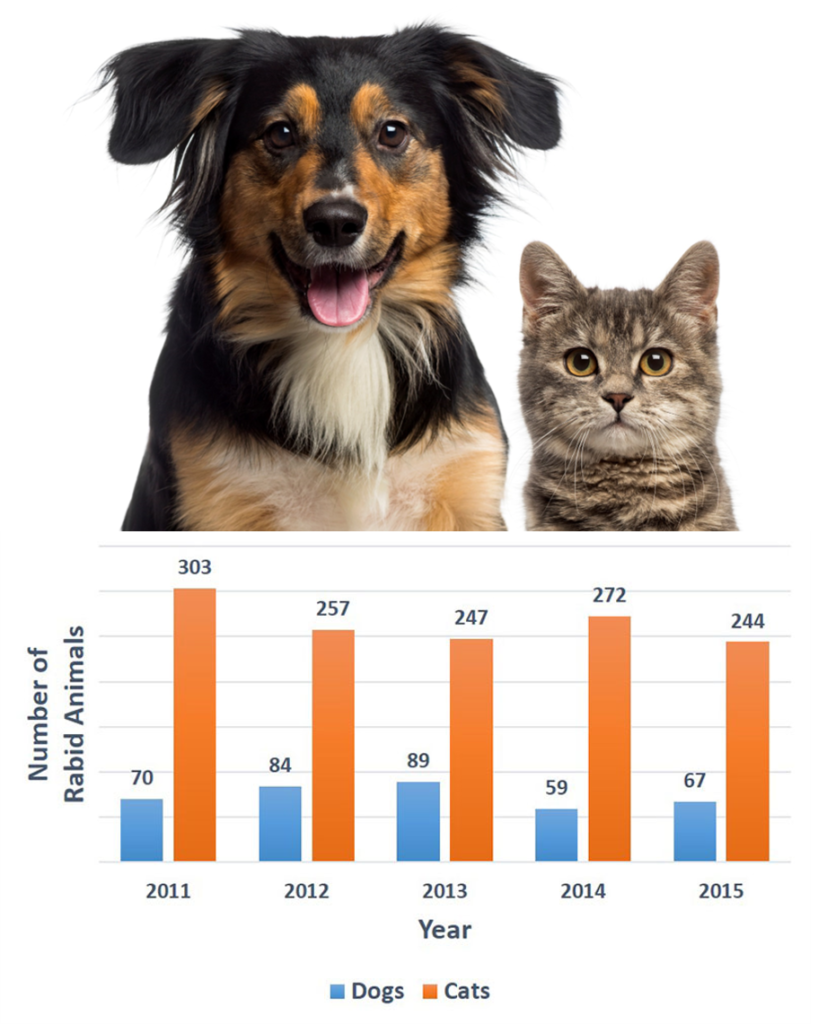Today is World Rabies Day, a global health observance started in 2007 to raise awareness about rabies and bring together partners to enhance prevention and control efforts worldwide.
While rabies is a 100% preventable disease, more than 59,000 people die from the disease around the world each year. World Rabies Day is an opportunity to reflect on our efforts to control this deadly disease and remind ourselves that the fight is not yet over.

In the U.S., the animals that get rabies the most are raccoons, skunks, foxes, and bats. Source: CDC
The group of viruses that cause rabies are present on every continent except Antarctica. People usually get rabies when they are bitten by an animal that has the virus. Rabies is nearly always fatal once symptoms appear, but rabies in humans is 100% preventable through prompt and appropriate medical care. In the U.S., the animals that get rabies the most are raccoons, skunks, foxes, and bats.
Canine rabies (which spreads between dogs and occasionally to humans) is the cause of 98% of human deaths worldwide. While the U.S. successfully eliminated the canine rabies virus, we still need to keep our dogs and cats vaccinated to prevent this kind of virus from coming back, and to protect our pets from contracting rabies from wildlife.
What You Can Do to Protect Yourself and Others from Rabies
Whether you are a pet owner, a parent, an outdoor adventurer or a backyard explorer, there are steps you can take to keep yourself and your family free from rabies throughout the year. Help stop rabies by sharing these messages with others.
Take Pets to a Veterinarian for Their Rabies Shot
 A veterinarian can make sure your pets – like dogs, cats, and ferrets – are up to date on their rabies shot and protected from getting rabies. All dogs and cats should be vaccinated around four months of age, and then again one year later.
A veterinarian can make sure your pets – like dogs, cats, and ferrets – are up to date on their rabies shot and protected from getting rabies. All dogs and cats should be vaccinated around four months of age, and then again one year later.
After these two shots, your veterinarian will develop a vaccination plan that is best for your pet and complies with local laws. This is important, since animals that have not received a rabies shot and are in contact with potentially rabid wild animals may need to be quarantined or euthanized.
Talk to your veterinarian about spaying or neutering your pet. This helps cut down on the number of unwanted and stray animals, which often do not have their rabies shot and are in close contact with wild animals.
Protect Your Family Around the Home
There are things you can do around the home to help reduce the risk of rabies to you and your pets.
- Keep your pets indoors. When you let your dog or cat go outside, it’s best to have a fenced-in yard and make sure someone is there to watch it and keep it safe. Use a leash when walking your dog.
- Keep your pets’ food in a place where only your pets have access to it and keep garbage securely covered. These items may attract wild animals or stray animals to your yard.
- Understand the risk from bats. While most wild animals are found primarily outdoors, bats can sometimes fly into buildings. This includes your home and even the room where you sleep. Learn what to do when you find a bat in your home. There are also steps you can take to “bat-proof” your home.
- Indoor-only cats do occasionally develop rabies because of bats in the home. It is important to keep all cats up to date on rabies vaccination, even if they never leave your home.
Keep Away From Wildlife and Unfamiliar Animals
In the United States, rabies is most often seen in wild animals such as raccoons, bats, skunks and foxes. One of the best ways to protect yourself and your family is to avoid contact with wild animals. Do not feed or handle them, even if they seem friendly. You should also avoid dogs and cats that are unfamiliar to you and your family. These animals may be in contact with wildlife and can also spread rabies to humans.
If you see an animal acting strangely, report it to animal control or your local health department. Some things to look for are:
- General sickness
- Problems swallowing
- Lots of drool or saliva
- An animal that appears more tame than you would expect
- An animal that bites at everything
- An animal that’s having trouble moving or may even be paralyzed
Never pick up or touch dead animals. The rabies virus may still be present in the saliva or nervous tissue, especially if they have only been dead for a short time. If you see a dead animal, call animal control.
Protect Yourself Before International Travel
Before traveling abroad, consult your doctor, a travel clinic, or your local or state health department about your risk of exposure to rabies and how to handle an exposure should it arise. When traveling, it is always best to avoid approaching any wild or domestic animal. In certain areas of the world, including parts of Africa, Asia, and Central and South America, rabies in dogs is still a major problem, and access to preventative treatment may be hard to get.
Rabies vaccination may be recommended before your trip if you are traveling to a country where there is an increased risk of rabies, especially if you may be more likely to come into contact with rabid dogs. You should also consider rabies vaccination if you will be spending a lot of time outdoors in rural areas or if you plan to handle animals.
For more information, please visit the CDC.